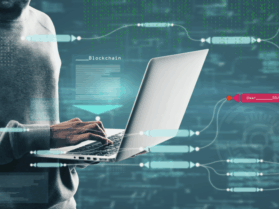Ensuring cybersecurity is important for companies, regardless of their size. Protecting against cyber threats is a significant issue for individuals and organizations. The amount of sensitive data has increased with the rise in technology, which has created more risks and threats to protect this data. It has become a challenging task to keep this data safe. Cybersecurity protects data and ensures trust, compliance, and business continuity without any hassle for organizations. In this blog, we will understand the latest cybersecurity trends to stay ahead of possible risks.
Top 10 Cybersecurity Trends
Earlier, the main focus of cybersecurity was creating strong barriers, like firewalls and antivirus programs, to keep threads away and create a safe boundary around networks. But this approach has its weaknesses, as attackers find ways through tricks or by exploiting software flaws.
In contrast to this, in 2024, cybersecurity took a much more holistic approach toward landscape shifts. Techniques such as Zero Trust architectures arise, which assume that the threat could both reside outside and inside the network. This shift reflects a recognition that security can be integrated at every level, from user authentication to encrypting data. This means that rather than relying on static defense, organizations should focus on continuous monitoring and adaptive responses. Let’s learn about the top 10 cybersecurity trends to follow in 2024:

1. Growing focus on AI and ML: The rise of artificial intelligence (AI) and machine learning (ML) has transformed cybersecurity. They have become an essential tool in the cybersecurity landscape. These technologies identify large amounts of data to detect patterns that help to search for threats faster. It is expected that in 2024, many organizations will adopt AI-driven solutions for better results.
For instance, according to a report published in 2023, Palo Alto claims those who used AI for detection of threats reduced their incident response times by 40%. Those technologies analyze large amounts of data automatically to detect patterns and anomalies during real-time operations that make them easier to spot threats in time.
2. Ransomware Attacks: The growing ransomware attacks have made businesses focus and prepare for such attacks. By maintaining regular backups, employee training, and incident response plans businesses can avoid such attacks.
For example, as per source, in 2023, ransomware attacks became a serious problem, as around 2300 complaints were reported to the FBI, resulting in a loss of around USD 34 Million. Cybercriminals are now using improved techniques of targeting small as well as big businesses, so organizations can only be well-prepared for ransomware.
3. Zero Trust Architecture: The Zero Trust Model (ZTM) is based on the "never trust, always verify" principle. It has replaced the traditional security model structure. This process needs continuous authentication and authorization for users and devices; thus, it reduces the risk of data breaches and increases security.
For instance, in 2023, as per the source, around 90% of Microsoft enterprise customers are using Zero Trust principles. Zero Trust principles ensure that login and access are authenticated continuously, thereby reducing the risk of data breach.
4. Growth of Cloud Security Solutions: An increasing need for effective cloud security solutions is observed, as companies are shifting toward the cloud. In 2024, the demand for tools and services that protect cloud environments will increase. This includes data encryption, access controls, and compliance measures to safeguard sensitive information stored in the cloud.
According to a report, in 2023, around USD 9.5 billion were spent on cloud security solutions, to protect sensitive information in a cloud environment.
5. Cybersecurity Skills Gap: There is a huge skills gap in the cybersecurity workforce. In 2024, organizations need to invest in training and development programs to upskill their existing staff. This focus on cybersecurity is important.
6. Supply Chain Security: The weak process of the supply chain has become a major source of cyber incidents. Attackers aim to attack third-party vendors, so they can access large organizations. To prevent such attacks, businesses need to pay attention to their supply chain security. This means carefully checking their vendors and putting stronger security measures in place.
7. Enhanced Privacy Regulations: Many governments have introduced strict regulations to protect data privacy. Organizations are supposed to follow these laws, such as the California Consumer Privacy Act (CCPA) and the General Data Protection Rules (GDPR). Organizations have to pay heavy fines for not following the rules. So, it is important for businesses to make privacy measures a top priority.
8. Biometric Authentication: Password authentication has become less reliable. To enhance protection, in 2024, biometric authentication methods will be used that may include fingerprint scanning and facial recognition. These technologies will add enhanced security layers to the system. This creates complications for unauthorized users to gain access to sensitive information.
As per the report, in 2023, 65% of organizations said they plan to use biometric authentication methods in the coming year to improve their security.
9. Cybersecurity Awareness Training: Human errors are major causes of data breaches. In 2024, organizations need to focus on awareness training for employees for cybersecurity. Regular training will help staff identify phishing attempts, social engineering tactics, and other threats, which will help to reduce cyberattacks.
10. Cyber Insurance: Rising cyber threats have made cyber insurance important. Businesses are now investing in cyber insurance policies to minimize the financial impact of cyber incidents. These policies cover expenses related to data breaches, ransomware attacks, and other cybersecurity events.
Final Words!
Cybersecurity is extremely dynamic. As users, we need to stay updated with the latest trends to ensure the protection of sensitive information and maintain trust. Focusing on the above-mentioned trends will help businesses to face the challenges up ahead. The adoption of new technologies, enhancement in security measures, and prioritizing employee training will shape how we navigate the cybersecurity complex in the future. Moving ahead, let’s commit to building a safe and secure environment.
To know more about Cybersecurity, visit us at SecureITWorld!
Read More:
What is COPPA? How Does it Safeguard Children’s Privacy
Harnessing the Power of AI in Cybersecurity — Predictions and Solutions





